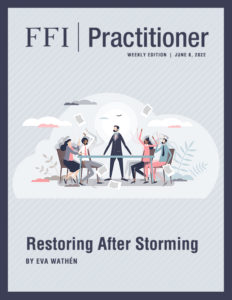
View this edition in our enhanced digital edition format with supporting visual insight and information.
In this week’s edition of FFI Practitioner, Eva Wathén provides an introduction to Restorative Mediation and explores its potential benefits as a method of conflict management for family enterprises.
My recent FFI Practitioner article compiled my findings on what contributes to a resilient family business owner. These qualitative interviews highlighted the importance of shared values and well-functioning, intergenerational relationships. However, the way conflicts were managed differed among participants, from avoidance to active and assertive conflict management.
In this article, I would like to focus on Restorative Mediation, in which participants reassess and redefine the conflict so that the parties can effectively work together employing more resources than they had before the conflict. Restorative Mediation can be a useful conflict management approach to families and family businesses because it integrates multiple lenses.1
One could say that the aim of this approach is aligned with the “More than lens” concept put forth by Oiu and Freel2 in a recent FBR article:
- Either-or lens: conflict management is situational and contextual. The solution is based on defending one’s own views or adapting to others’ viewpoints. Adapting, backing off, exiting, or competing can be ways to reach an outcome.
- Both-and lens: this lens includes the interdependencies and interrelations of parties involved, e.g., the different views of minority and majority owners. The solution is sought by fitting the views together, either by compromise or cooperation.
- More-than lens: the conflict is managed in a processed, structured, and dialogical manner, using multiple perspectives, with an aim to arrive at a redefinition of the conflict that the parties can feel part of.
My experience is that many family business conflicts have deep roots, which necessitate a reassessment of the situation to pinpoint inherited working methods or thinking patterns that no longer serve the situation at hand—all at a speed suitable to the participants’ needs.
Causes of Conflict in Family Enterprises
Conflicts in family enterprises can result from different views on tasks to complete, the way they should be completed, and the way people interact and use their power in completion and decision-making. The bigger the family grows, the higher the risk for conflicts. Clear governance rules, together with consistent and well-processed owner strategy processes, can greatly mitigate this risk. However, I have observed in many family enterprises that a discussion deficit—a lack of productive conversations among key stakeholders—might have roots that go back many years. This long-standing discussion deficit can increase the difficulty of arriving at sustainable solutions that all the participants can feel part of. Another observation concerns the way family members who actively participate in the enterprise seem to have an urge to catch up with this deficit by attempting to speed up the process—yet speed and sustainable solutions are not always the best of mates. Big questions require ample time, sufficient processing, depth, and respect for a variety of processing styles if all participants are to work together.
Emotional bonds and lack of communication can further complicate family business conflict management. Indeed, it is not uncommon that conflicts are silently managed within the family or at times totally denied—denial and avoidance may even rest on good intentions. A seemingly harmonious status quo may appear less risky than active conflict resolution since family members often cannot walk away from conflict without risking their extended family relationships. Therefore, it is often more tempting to avoid, postpone, or deny the conflict.
The first two lenses of Qiu and Freel’s research seem especially handy in quick-fix, less complex conflict situations. The more-than lens is suitable for far-reaching, sustainable, and complex solutions, and an outside professional can offer the group a wider perspective.
Restorative Mediation
A restorative mediator attempts to facilitate the discussions equally, neutrally, and respectfully, ensuring overall psychological safety. The discussions aim at restoring the relationships through dynamic, dialogue-based communication.3 Ideally the process flows from individual discussions and group discussions towards a collective agreement. The process provides a possibility for mutual forgiveness, although this is not a prerequisite.
In essence, restorative mediation positions the conflict so that all parties can assess it from a distance. The restorative mediator uses compassion, empathy, and assertiveness to find new and sustainable solutions to the situation. The question is not who was to blame, but rather how to continue the future journey together. The restorative mediator’s role is to help reflect upon patterns and practices, and to challenge outdated norms when necessary. Emotions are treated as resourceful information and family members are encouraged to share these feelings.
Financial and Management Implications
In family enterprises, conflicts consume energy and cash, and they threaten long-term family unity. The majority of succession processes fail because of communication challenges among family members.4 Also, conflict management globally can take up to 25-30% of leaders’ time.5 Good mediators can deliver invaluable assistance and improve the time, energy, and financial resources spent by the company.

Tips for Advisors
When selecting or recommending a mediator for a family enterprise client, Qiu & Freel suggest that special attention should be paid to the following:
- Sufficient distance between the mediator and the parties involved so that objectivity is not jeopardized
- Ensuring that no mediator benefits are tied to the mediation outcome
- Ensuring good understanding of the power dynamics prevailing in the family business
Not only are egos, emotions, traditions, and close relationships affecting daily interactions, but also the working life in general. Multichannel communication, an uncertain future, and new hybrid working modes are shaping employee experiences. Good communication and leadership skills are the best remedies to tackle the complex, non-linear outcomes. Yet, some situations may develop to a point where outside mediation is needed in order to redefine and reposition the conflict.
Due to the complex dynamics and often complicated nature of conflict that may exist within an enterprising family, Restorative Mediation may represent an advantageous approach for your clients to consider to resolve their conflicts in a psychologically safe environment.
References
1 Restorative mediation is based on the approach offered by restorative justice and also shares the majority of values used in the process. European Forum for Restorative Justice defines restorative justice as “an approach of addressing harm or the risk of harm through engaging all those affected in coming to a common understanding and agreement on how the harm or wrongdoing can be repaired and justice achieved.” See European Forum for Restorative Justice. (2022, June 2). Why restorative justice matters? https://www.euforumrj.org/en
2 Qiu, H., & Freel, M. (2020). Managing Family-Related Conflicts in Family Businesses: A Review and Research Agenda. Family Business Review, 33(1), 90–113. https://doi.org/10.1177/0894486519893223
3 Dialogue-based communication lies at the core of how restorative mediation is practiced. Dialogue is needed in order to restate and restore the situation at hand. Moreover, it represents multi-directional sharing and equal exchange rather than uni-directional information transmission. See Lappalainen, P. (2020). Walking and Talking Sensors: Conceptualising Restorative Leadership to Enhance People Management Education in Engineering. European Journal of Engineering Education, 45:3, 473-490. https://doi.org/10.1080/03043797.2019.1646211
4 Williams, R., & Preisser, V. (2005). Philanthropy, Heirs & Values: How Successful Families Are Using Philanthropy to Prepare Their Heirs for Post-transition Responsibilities. San Francisco: Robert D. Reed Publishers.
5 Lewis, C. (2009). The definitive guide to workplace mediation and managing conflict at work. Weybridge: Roper Penberthy Publishing.
About the Contributor

Eva Wathén, ACFBA, CFWA, is cofounder of Bravemotion Oy in Finland. Bravemotion Oy’s services for family businesses include facilitating owner strategies, communication, and trainings for family businesses, as well as coaching key players in multiple generations of family firms. Eva is a third-generation family business owner, having served in several different roles. She has more than 25 years of experience working in or with family businesses. She can be reached at eva.wathen@bravemotion.com.

View this edition in our enhanced digital edition format with supporting visual insight and information.



